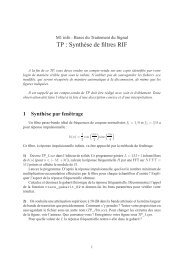Th`ese de Doctorat de l'université Paris VI Pierre et Marie Curie Mlle ...
Th`ese de Doctorat de l'université Paris VI Pierre et Marie Curie Mlle ...
Th`ese de Doctorat de l'université Paris VI Pierre et Marie Curie Mlle ...
You also want an ePaper? Increase the reach of your titles
YUMPU automatically turns print PDFs into web optimized ePapers that Google loves.
comes smaller than the application transmission rate. For <strong>de</strong>lay-adaptive audio and vi<strong>de</strong>o<br />
applications, the utility function curves can look like that in Figure 2.1(c).<br />
Another class of real-time applications is represented by rate-adaptive applications.<br />
These applications do not require hard bandwidth guarantees and hence they can adapt<br />
their transmission rate in response to n<strong>et</strong>work congestion. The utility function for rate-<br />
adaptive applications has the shape shown in Figure 2.1(d).<br />
Pricing<br />
The pricing can represent an important component of bandwidth utility functions [2, 26].<br />
Dynamic pricing mechanisms can take advantage of application adaptivity to increase<br />
n<strong>et</strong>work availability, revenue, and user-perceived utility [2].<br />
In a n<strong>et</strong>work with QoS support, pricing of n<strong>et</strong>work services based on the level of service,<br />
usage, and congestion provi<strong>de</strong>s an incentive for applications to adapt their sending rates<br />
according to n<strong>et</strong>work conditions. Increasing the price during congestion gives the applica-<br />
tion an incentive to back-off its sending rate and at the same time allows an application<br />
with more stringent bandwidth and QoS requirements to maintain a high quality by paying<br />
more.<br />
A number of pricing schemes are used in the Intern<strong>et</strong> today like access-rate-<strong>de</strong>pen<strong>de</strong>nt<br />
charge, volume-<strong>de</strong>pen<strong>de</strong>nt charge, or the combination of the both. These charging schemes<br />
are <strong>de</strong>scribed in [26].<br />
2.2 Dynamic Bandwidth Allocation Algorithms<br />
2.2.1 Max-Min Fair Allocation Algorithms<br />
Several algorithms have been proposed to allocate n<strong>et</strong>work resources fairly among com-<br />
p<strong>et</strong>ing connections. A max-min fair allocation algorithm is introduced in [13] to allocate<br />
25










